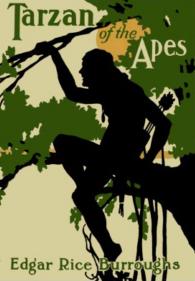
Tarzan of the Apes is a 1912 novel by American writer Edgar Rice Burroughs, and the first in the Tarzan series. The story was first printed in the pulp magazine The All-Story in October 1912 before being released as a novel in June 1914.
Opar is a fictional lost city in the Tarzan novels of Edgar Rice Burroughs and later the Khokarsa novels of Philip José Farmer and Christopher Paul Carey, as well as various derivative works in other media.

La is a character in Edgar Rice Burroughs's series of Tarzan novels, the queen and high priestess of Opar, a lost city in the jungles of Africa.Opar is portrayed as a surviving colony of ancient Atlantis in which incredible riches have been stockpiled down through the ages. The city's population exhibits extreme sexual dimorphism caused by a combination of excessive inbreeding, cross-breeding with apes, and selective culling of offspring. Consequently, female Oparians are physically perfect, while male Oparians are hideous bestial creatures.

Tarzan the Untamed is a book by American writer Edgar Rice Burroughs, the seventh in his series of twenty-four books about the title character Tarzan. It was originally published as two separate stories serialized in different pulp magazines; "Tarzan the Untamed" in Redbook from March to August, 1919, and "Tarzan and the Valley of Luna" in All-Story Weekly from March to April 1920. The two stories were combined under the title of the first in the first book edition, published in 1920 by A. C. McClurg. In order of writing, the book follows Jungle Tales of Tarzan, a collection of short stories about the ape-man's youth. Chronologically, it follows Tarzan and the Jewels of Opar.

Hadon of Ancient Opar is a fantasy novel by American writer Philip José Farmer, first published in paperback by DAW Books in April 1974, and reprinted three times through 1983. The first British edition was published by Magnum in 1977; it was reprinted by Methuen in 1993. The first trade paperback edition was published by Titan Books in 2013. The work has also been translated into French. It was later gathered together with its sequels Flight to Opar and The Song of Kwasin into the omnibus collection Gods of Opar: Tales of Lost Khokarsa (2012). It and its sequels purport to fill in some of the ancient prehistory of the lost city of Opar, created by Edgar Rice Burroughs as a setting for his Tarzan series.

The Return of Tarzan is a novel by American writer Edgar Rice Burroughs, the second in his series of twenty-four books about the title character Tarzan. The story was first published in the pulp magazine New Story Magazine in the issues for June through December 1913; the first book edition was published in 1915 by A. C. McClurg.

Tarzan and the Ant Men is a novel by American writer Edgar Rice Burroughs, the tenth in his series of twenty-four books about the jungle hero Tarzan. It was first published as a seven-part serial in the magazine Argosy All-Story Weekly for February 2, 9, 16 and 23 and March 1, 8 and 15, 1924. The story was first published in book form in hardcover by A. C. McClurg in September 1924. It was also adapted for Gold Key Comics in Tarzan #174-175 (1968).

The Son of Tarzan is a novel by American writer Edgar Rice Burroughs, the fourth in his series of twenty-four books about the title character Tarzan. It was written between January 21 and May 11, 1915, and first published in the magazine All-Story Weekly as a six-part serial from December 4, 1915, to January 8, 1916. The story was first published in book form by A. C. McClurg & Co. in March 1917 and has been reprinted numerous times since by various publishers.
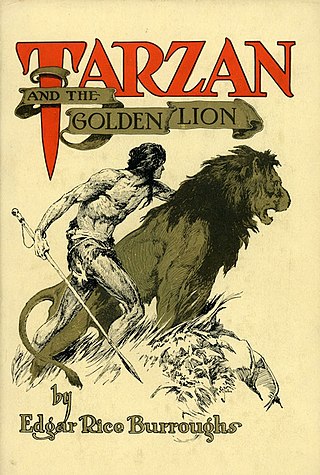
Tarzan and the Golden Lion is an adventure novel by American writer Edgar Rice Burroughs, the ninth in his series of twenty-four books about the title character Tarzan. The story was first published as a seven part serial in Argosy All-Story Weekly beginning in December 1922; and then as a complete novel by A.C. McClurg & Co. on March 24, 1923.
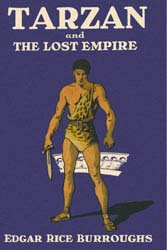
Tarzan and the Lost Empire is a novel by American writer Edgar Rice Burroughs, the twelfth in his series of twenty-four books about the title character Tarzan. The story was first published as a serial in Blue Book Magazine from October 1928 through February 1929; it first appeared in book form in a hardcover edition from Metropolitan Newspaper Services in September 1929. This was the first Edgar Rice Burroughs book not published by A. C. McClurg, with whom Burroughs had cut off business ties due to a dispute over royalties.
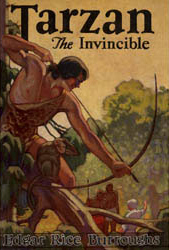
Tarzan the Invincible is a novel by American writer Edgar Rice Burroughs, the fourteenth in his series of twenty-four books about the title character Tarzan. The novel was originally serialized in the magazine Blue Book from October, 1930 through April, 1931 as Tarzan, Guard of the Jungle.

Tarzan and the City of Gold is a novel by American writer Edgar Rice Burroughs, the sixteenth in his series of twenty-four books about the title character Tarzan. The novel was originally serialized in the magazine Argosy from March through April 1932.

Tarzan and the Forbidden City is a novel by American writer Edgar Rice Burroughs, the twentieth in his series of twenty-four books about the title character Tarzan.
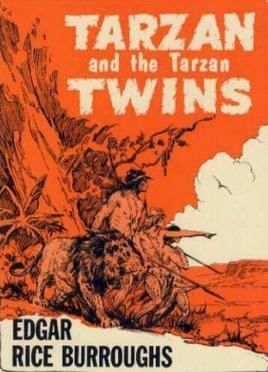
Tarzan and the Tarzan Twins is a collection of two Tarzan novellas by American writer Edgar Rice Burroughs, for younger readers. It was originally published as two children's books, The Tarzan Twins by Voland in October 1927, and Tarzan and the Tarzan Twins, with Jad-bal-ja, the Golden Lion, by Whitman in March 1936. These were brought together in November 1963 under the title of Tarzan and the Tarzan Twins in the first complete edition.

Tarzan the Tiger (1929) is a Universal movie serial based on the novel Tarzan and the Jewels of Opar by Edgar Rice Burroughs. It stars Frank Merrill as Tarzan, Natalie Kingston as Jane, and Al Ferguson. It was directed by Henry MacRae.

The Adventures of Tarzan (1921) is a 15 chapter movie serial which features the third and final appearance of Elmo Lincoln as Tarzan. The serial was produced by Louis Weiss, written by Robert F. Hill and Lillian Valentine, and directed by Robert F. Hill and Scott Sidney. The first chapter was released on December 1, 1921.

Tarzan is a fictional character, a feral child raised in the African jungle by the Mangani great apes; he later experiences civilization, only to reject it and return to the wild as a heroic adventurer.
The Waziri are a fictional African tribe created by Edgar Rice Burroughs in his Tarzan novels. Burroughs characterizes the Waziri as the greatest warriors in Africa, though small in numbers. They are feared by Arabic ivory and slave traders as well as cannibal tribes, and known from western to eastern Africa. The Waziri also appear in other media based on the novels.

Tarzan is a series of 24 adventure novels written by Edgar Rice Burroughs (1875–1950) and published between 1912 and 1966, followed by several novels either co-written by Burroughs, or officially authorized by his estate. There are also two works written by Burroughs especially for children that are not considered part of the main series.

The Dark Heart of Time: A Tarzan novel is a novel by American writer Philip José Farmer, authorized by Edgar Rice Burroughs, Inc. Published in 1999, the book was first announced under the title Tarzan's Greatest Secret in 1997. A 2018 reissue of the novel marked the book's first hardcover edition, and was retitled Tarzan and the Dark Heart of Time.

















